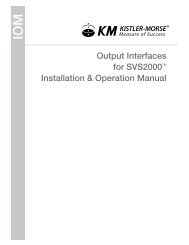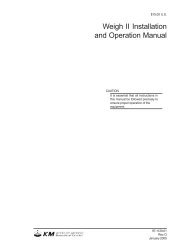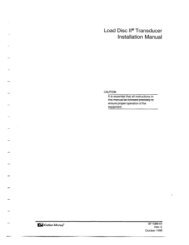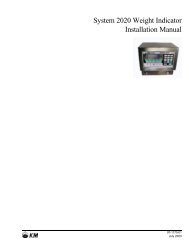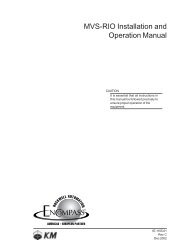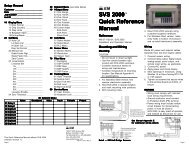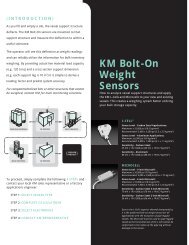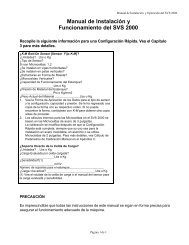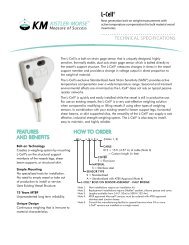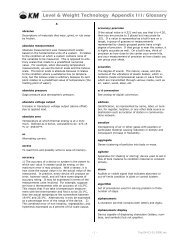STX Signal Transmitter Installation and Operation ... - Kistler-Morse
STX Signal Transmitter Installation and Operation ... - Kistler-Morse
STX Signal Transmitter Installation and Operation ... - Kistler-Morse
Create successful ePaper yourself
Turn your PDF publications into a flip-book with our unique Google optimized e-Paper software.
Chapter 7. MVS-<strong>STX</strong> Calibration Menu<br />
10. Press the F3 Key to access HiSpan. The<br />
display looks like this:<br />
HI SPAN AUTO CAL<br />
> 9999 lbs<br />
F1 F2 F3<br />
(Units are consistent with Units Menu.)<br />
11. Use the keypad or Arrow Keys to input a<br />
value that represents the quantity of<br />
material added to the vessel. Press the<br />
Enter Key. The display acknowledges the<br />
entry <strong>and</strong> returns to:<br />
AUTO CAL MENU<br />
LoSpan<br />
HiSpan<br />
F1 F2 F3<br />
12. Press the Esc Key to scroll up the menu<br />
tree or press the Auto/Man Key to return<br />
to channel monitoring.<br />
Calibration by Adding a<br />
Known Quantity of Material<br />
This calibration method does not require the<br />
vessel to be empty. The principle behind the<br />
calibration follows.<br />
A weight estimated to be the quantity of<br />
material in the vessel is entered as the<br />
Lo Span weight [point (1) in Figure 7-3].<br />
A known quantity of material, representing at<br />
least 25% of the vessel’s total capacity, is<br />
added to the vessel. The sum of the known<br />
quantity plus the estimated quantity is<br />
entered as the Hi Span weight [point (2) in<br />
Figure 7-3]. The MVS saves in memory the<br />
Lo Span <strong>and</strong> Hi Span weights as well as the<br />
digital counts associated with each weight.<br />
These values define the dashed straight line<br />
<strong>and</strong> the calculated zero counts shown in<br />
Figure 7-3. The slope of the line is called the<br />
Scale Factor, which is calculated internally.<br />
The slope of the line is reasonably accurate,<br />
because it is calculated based on the known<br />
difference between the Lo Span <strong>and</strong> Hi Span<br />
weights <strong>and</strong> counts. However, if the estimated<br />
Lo Span weight is incorrect, the actual<br />
‘location’ of the line is incorrect, resulting in<br />
errors in channel monitoring. The greater the<br />
error in the estimated Lo Span, the greater<br />
the resulting error. The ‘location’ of the line<br />
can be adjusted to the solid line by setting<br />
zero [point (3) in Figure 7-3] (see Refining the<br />
Calibration by Setting Zero in this section).<br />
The greater the known quantity of material<br />
added during the calibration procedure, the<br />
greater the accuracy of the calibration.<br />
Adding 50% of the total capacity results in<br />
greater accuracy than adding 25% of the<br />
total capacity.<br />
Follow this procedure to calibrate by adding a<br />
known quantity of material:<br />
1. If in Auto Mode (Auto LED illuminated),<br />
press the Auto/Man Key to put the MVS<br />
in Manual Mode. The Auto LED turns off.<br />
2. Use the Arrow Keys to scroll to the<br />
desired channel.<br />
Indicated<br />
Weight<br />
Added or<br />
Subtracted<br />
Known<br />
Quantity<br />
Estimated<br />
Hi Span Weight<br />
(1)<br />
(2)<br />
Scale Factor Weight<br />
Slope =<br />
Scale Factor Counts<br />
Scale Factor Wt = Hi Span Wt - Lo Span Wt<br />
Scale Factor Cnts = Hi Span Cnts - Lo Span Cnts<br />
Estimated<br />
Lo Span<br />
Weight<br />
Corrected Calibration Line,<br />
Same Slope<br />
Calculated<br />
Zero Counts<br />
(3)<br />
Setting<br />
Zero<br />
Lo Span<br />
Counts<br />
Hi Span<br />
Counts<br />
Figure 7-3. Calibration by Adding or Subtracting a Known Quantity of Material<br />
7-3<br />
Weight<br />
<strong>Signal</strong><br />
in Counts



